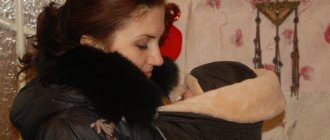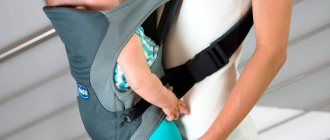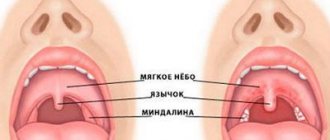How to put on a sling
The BiBi ring sling is always worn on one shoulder. Since the design of the sling is symmetrical, it does not matter which side you put it on. Typically, the sling is worn on the right shoulder if the adult is right-handed, and on the left shoulder if the adult is left-handed. However, do not forget to periodically change the side you are wearing. These instructions describe how to put on and wear the sling on your right shoulder.
| 1. Take the sling with your right hand by the rings so that the tail of the sling, threaded through them, is in front. | 2. Place your left arm and head into the sling. The rings should be just below your shoulder. | 3.Spread the sling over your shoulder. The sling is put on, now you can place the baby in it. |
How to choose a sling for a newborn
How to make a sling for a newborn with your own hands
The choice of sling or the creation of a wrap depends on the age and development of the child. Before creating a wrap yourself, a young mother needs to have a good understanding of how to tie a sling scarf for newborns. For this purpose, you can watch training videos on special websites. It is better to choose a professional consultation - for example, from a specialist from the League of Sling Consultants.
Age: newborn (baby cannot support his head and back) What to wear
- Sling scarf (you can use a knitted or woven scarf). Woven sling scarf-wrap for newborns: cross over the pocket (baby in front or behind the back), robin (baby in front or on the side), kangaroo (baby in front or on the side), rebozo-wraps with a sliding knot or knot on the back, backpack behind back; Knitted scarf: cross under the pocket, robin on the side with straightened panels;
- Ring sling: ring sling, how to carry a newborn: front and side;
- May-sling for newborns: exclusively made of plastic fabric with a headrest; twists and crosses on the child’s back cannot be used in winding;
- Backpack: one where it is possible to pull the child tightly and release his legs outward from the knee; there should be no fasteners or slings running along the lower back.
Age: 3 months (baby holds his head, including in a position on his stomach, rises, tries to roll over) Age: 4-6 months (baby confidently holds his back, rolls over, leans on outstretched arms, learns to get on all fours) What to wear
- Previous windings;
- Woven sling scarf: cross under pocket at front, simple cross at front and hip, double rebozo at back and front, Jordan at back;
- Sling with rings: on the hip;
- May-sling: on the hip, behind the back.
Age: 6 months (baby learns to sit or sits confidently on a flat surface without support and does not fall over on its side) Age: 9 months (baby stands holding support) What to wear
- All previous windings;
- Ergonomic backpack.
Age: 1 year (baby walks) What to wear
- All previous windings;
- Tibetan cross;
- Hipsit
Sling for twins
Experts do not recommend that young mothers without babywearing experience use one sling for twins. Firstly, the load for a woman is too great (difficult pregnancy, physical fatigue, etc.), and secondly, it will not be possible to wind a scarf correctly on the first try. Thirdly (and most importantly), the weight of twins is usually different and this must be taken into account when winding.
However, if a mother takes a training course from an expert and masters winding with the “yoke” effect, this will be a good help in everyday life, and the load will be distributed evenly on the woman’s shoulders. To make such a winding, you need to master the double rheobozo-cross method over the pocket. Babywearing consultants consider it unsafe to use a single-layer wrap for twins in one scarf.
Still, the best option for a mother of twins would be a combination of a stroller and a sling for newborns: this way the woman will feel the greatest safety.
When you should not use a sling for newborns in a horizontal position (cradle position):
- if the baby is premature, because there is a risk of respiratory arrest (apnea);
- if the child has problems or pathologies in the development of the hip joints, dysplasia;
- if the baby has developmental delays or health problems (hypotonia, epilepsy, respiratory pathologies);
- in a baby who is suffering from acute respiratory viral infection or another disease in which breathing may be difficult;
- When choosing the “cradle” position, you must remember that the child’s breathing and posture should be constantly monitored. In addition, the position of the head must be changed regularly (from left to right and vice versa) so that the load on the muscles and spine is the same;
- Under no circumstances should you carry a child in a “cradle” position under babywearing clothing.
How to adjust the sling
After the sling is put on, we place the baby in it. Therefore, at first it should be slightly loose. When the baby is in the sling, you should carefully adjust the length of each side so that the sling securely fixes and presses the baby to you. Carrying in a sling is easy because it allows you to press the baby to the adult's body. If the sling is not adjusted, carrying the baby will be uncomfortable. Supporting your baby with one hand, pull up each edge in turn. If you do not support the child, the fabric will be pinched in the rings under the weight and it will be very difficult to adjust the sling. The correct location of the rings is in the collarbone area. If they are higher, they will put pressure on the shoulder, if lower, there will be little room for the child in the sling.
| 1. To reduce the length of the top edge of the sling, pull the left edge of the tail. | 2. To reduce the length of the bottom edge of the sling, pull the right edge of the tail. | 3. To decrease the depth of the sling, pull on the middle of the tail. |
| 4. To increase the volume of the sling while supporting the baby, lift the ring on top. The sling will weaken under the baby's weight. You can also pull the top edge in the opposite direction. | ||
How to make (sew) a sling with rings with your own hands: instructions
While on maternity leave before the baby is born, many mothers find solace in creating something new. To make your future life easier, you can learn how to sew a sling yourself. This is not difficult to do, just select high-quality material: rings, threads and fabric, thread the fabric through the rings and stitch it several times.
- Take the fabric and cut out a rectangle measuring 220 by 80 cm.
- We sew the fabric along the perimeter, except for one narrow edge.
- We thread the unstitched edge of the fabric into 2 rings and attach it.
Cradle, legs to rings, option 1
Age: from birth This method and its variations allow you to place the child horizontally in a sling, like in a hammock. The “cradle” can be used from the birth of the child until the child agrees to lie down in the sling. If the child no longer fits completely in the sling, make it a rule: the child’s head and butt must be supported, regardless of his age and weight, and the legs from the knees can be outside. A child in a sling can lie on his back or on his side (stomach to stomach of an adult). The arms can be crossed on the chest or hugging the mother. If the child lies calmly, it means you did everything right.
| 1. Straighten the sling by pulling its edges to the sides. | 2. Take the child on the forearm of your left hand, with the head to the elbow and the palm supporting under the butt. | 3. Place your hand with your baby in the sling. |
| 4. With your other hand, simultaneously straighten the sling until the baby is completely inside it. | 5. While supporting the child, pull up the top edge first, then the bottom. | 6. Straighten the strap over your shoulder. |
How to carry a baby correctly?
To make it comfortable to wear a sling, you need to sit the baby down correctly, otherwise there is a risk that the baby will fall. A newborn or newborn is placed in a sling according to the following rules:
- In the “column” position, the child is placed on the shoulder opposite the rings. Based on the baby's growth, the fabric is stretched to the base of the head. Holding the fabric from above with one hand, straighten the fabric from below with the other hand, covering the baby’s legs.
- To ensure comfort and safety, the remaining fabric needs to be adjusted in length. A newborn or newborn, while in a sling, should cling tightly to the mother's chest.
- If the child is older, it is not necessary to cover the legs and head with cloth. A very tiny baby, on the contrary, should be properly covered, since his musculoskeletal functions are not yet developed and there is a risk of injury.
- During feeding, you should correctly release the ring, pull back the fabric and lay the baby opposite the rings, and free the legs from the fabric.
- If the child does not know how to hold his head up, he can be carried in a sling while lying down, placing his head towards the rings, but so that he does not touch them. The fabric must be properly secured and the baby's body pressed tightly to the mother's chest.
- During feeding or during the rest period, the baby's head should be held, and when he falls asleep, the ring should be tightened so that the baby's body is located closer to the mother's breast. In this way, you can wear the sling without the support of your hands, without fear for the safety of the baby.
- When turning or bending over, the sling must be held with both hands so that the free part of the fabric does not slide off the rings under the weight. The main rule before going outside is to practice using it at home.
Cradle, legs to rings, option 2
This method differs from the previous one in that the child is lowered into the sling from the shoulder, supported by the hand. First of all, it is convenient when placing a heavy or large child in a sling, who is difficult to place in a sling when placed on the forearm.
| 1. Place the child on your left shoulder and support him with your hand. Place your right hand under the sling. | 2. Slowly lower the baby into the sling and grab him with your right hand. | 3. With your left hand, take the top edge of the sling and straighten it to the baby’s head. |
| 4. Lean forward and place the baby in the sling so that the head is supported. | 5. While supporting the child, pull up the top edge first and then the bottom edge. | 6. Straighten the strap over your shoulder. |
Cradle, legs to rings, option 3
Another way to put on a sling is for the “cradle, legs to rings” position. The sling is placed over the child's head.
| 1. Place the baby on the forearm of your right hand, butt to the elbow, and supporting the head with your palm. | 2. Use your left hand to wrap the sling over your baby. | 3. Spread the fabric out to the sides so that the head is supported. |
| 4. While supporting the child, pull up the top edge first and then the bottom edge. | 5. Straighten the fabric over your shoulder. |
Front facing mom
Age: from birth This method can also be used from birth, because the baby clings tightly to the mother (as if he is just in the arms of an adult), receives support from the sling over the entire area of the back and hips. Please note that the legs are spread and bent at the knees, and the back is slightly rounded: in this case, the load is removed from the spine.
| 1. Place the child on your left shoulder and support him with your hand. Place your right hand under the sling. | 2. Slowly lower the baby into the sling and grab him with your right hand. | 3. With your left hand, take the top edge of the sling and straighten it to the baby’s head. |
| 4. Place the baby in the sling by spreading his legs and bending them at the knees, giving him a “frog” position, and adjust the sides well. | 5. Done. The sling fabric tightly covers the baby. |
Kangaroo
Age: ~3 months The child is positioned facing forward, and the legs are folded in a Turkish sling or, in the case of a side position, extended forward.
| 1. Lift the inner edge of the sling and spread it around you. It should fit you tightly, and the sling itself now resembles a “pocket”. | 2. Lean the baby's back against you, fold his legs Turkish-style, and, supporting them, lower the baby into the sling. | 3. While settling the baby, use your other hand to lift the front edge of the sling up. |
| 4. While supporting your baby, adjust the top edge of the sling. | 5. Done. | 6. Alternatively, you can sit the child sideways to your body. |
On the hip
Age: ~3 months You can carry a baby on your hip if he is already holding his head. This is the most used position for most mothers. Many people carry their baby this way without a sling; practice carrying your baby on your hip. When putting on a sling to place a baby on your hip, it is more convenient to place the rings on your shoulder. When you move the child onto your hip, they themselves will move into the subclavian cavity.
| 1. Place the child on your left shoulder and support him with your hand. Place your right hand under the sling. | 2. Slowly lower the baby into the sling and grab him with your right hand. | 3. When the baby's butt is at the level of your waist, rotate the sling with the baby around you so that he is on your side. |
| 4. Spread the child’s legs and bend them at the knees so that he hugs your waist with his hips, place him in the sling. The bottom edge of the sling should go under the baby's knees, and the sling should cover the bottom. | 5. While supporting your baby, adjust the top and bottom edges of the sling. | 6. Done. The child should sit as if in a hammock, the fabric of the sling covers him from the knees to the shoulder blades. |
| 7. For children who have trouble holding their head up, you can straighten the sling to the back of the head. In this case, the baby's head will be pressed to the adult's chest. | 8. You can move the sling with the baby back, completely freeing up your view. To do this, when putting on the sling, place the rings behind your shoulder. Place your baby on your hip and slide him and the sling behind you. The rings will move forward into the subclavian cavity. |
How to place your baby in the hip position
When using this method, you need to place the shoulder of the sling on yourself in the area of the shoulder blade; a little later it will move to the required position. After which we take the child and place him on our shoulder, where there are no rings. We put our other hand through the pocket and find the newborn’s legs, after which we pass them through the sling and place the baby vertically on our chest so that the flagellum is directly under his knees.
Now you need to spread your legs to the sides so that your butt sag, your knees rise slightly up, your back is rounded. We pull the top side over the child, hiding his hands. Move the baby onto your side, making sure that the rings go down to the collarbone area. Then pull the baby tightly towards you using the tail of the sling.
Change of position
A ring sling makes it very easy to transfer your baby from a vertical to a horizontal position and vice versa without having to put it on again.
| 1. While supporting your baby, pull the ring up and loosen the top edge of the sling. | 2. Lean forward and place the baby horizontally in the sling. | 3. Adjust the edges. The baby is now in the “Cradle, feet to the rings” position. |
Similarly, the horizontal position changes to vertical.
How to place your baby in a horizontal position
Having chosen the “cradle” method, you need to pull the lower side so that it is located along the mother’s abdomen and points upward. We take the child and place him on our shoulder vertically on the side where there are no rings, while holding his head. With the other hand, passing it under the sling, we feel the newborn’s legs and smoothly lower him. The sling fabric with rings should be under the child’s knees. The baby must be positioned semi-sideways so that his lower arm hugs his mother and his head is located near her chest.
The legs are directed towards the rings, and the head, accordingly, in the opposite direction. It is important to straighten the top side well so that there are no folds under the baby’s back. It is best to support the baby's head with your hand and not completely cover it with cloth. The lower side must be adjusted under the knees so that the baby’s butt is located just below their level. Remember that the baby's body should be pulled towards the mother, but do not squeeze it.
How to breastfeed a baby in a sling
The sling is ideal for breastfeeding. This is especially true for newborns; the mother can feed the baby as often as required, and at the same time continue to do her business, because her hands remain free. And after feeding, the baby easily falls asleep right in the sling. In addition, the sling protects you from prying eyes. Not everyone will guess that you have a child nestled there.
In order for your child to take your first attempts well, provide him with maximum comfort. The baby in the sling should be in the same position as without it, that is, just in your arms. You can easily check whether you have positioned your baby correctly - hug him on top of the sling. If somewhere is too loose or tight, you need to tighten or loosen the fabric.
You can feed both in a horizontal position and in a vertical position - depending on the age of the child and the situation, and simply for whom it is more convenient. For example, it is especially convenient to feed very young children in one of the “cradle” positions. After eating, the baby falls asleep at the breast and you, if desired, can remove the sling together with the baby without disturbing him.
For babies of what age is this carrier best suited?
Many mothers and professional sling consultants believe that ring slings are ideal for carrying newborns. There are several obvious explanations for this.
Firstly, this product has a comfortable “cradle” position for babies and mothers (the baby lies exactly the same as in the mother’s arms). Moreover, nothing is easier than learning how to use it! After all, a sling with rings does not have complex windings, so it is very easy for mothers who are starting to use a sling for the first time to master it.
A sling with rings will serve well even when the baby grows up - up to 2-3 years, because such slings can also be worn in vertical positions: “facing the mother,” “on the hip,” “on the back.”
You will especially appreciate the beauty and versatility of a ring sling when your baby learns to walk. At this wonderful age, children are constantly asking to be held in their mother’s arms, or to stomp their feet. It will be very convenient and easy to take your restless baby out of the sling with rings, and then put him back in again!
Here are the main reasons why many mothers consider ring slings one of the essentials when giving birth to a baby:
- A ring sling provides a feeling of closeness to mom . The baby spent 9 months in his mother’s tummy, he really needs to continue to feel her warmth. This is why, according to a study by the Department of Pediatrics at the McGill University Research Center at the Montreal Children's Hospital (Montreal, Quebec, Canada), a healthy baby cries less often in a sling than in a crib or stroller.
- It is comfortable to breastfeed in a sling with rings , and you will be able to do this completely unnoticed, especially if you are also wearing special clothes for nursing mothers. You don’t have to expose your breasts to feed in a park, clinic or at a party, and experience discomfort from it! According to many, wearing a sling helps to establish and prolong breastfeeding, because the baby is close to the mother, which promotes the production of breast milk. It is very easy to rock your little one in your arms in a sling. And when the lulled baby falls asleep in the carrier, it will be so convenient for you to put him in the crib by simply loosening the fabric in the rings and removing the baby from you along with the sling!
- The sling eases the load on the wearer's back and arms . This is especially important in the postpartum period, when a woman should not overexert herself. Moreover, the sling frees up mother's hands. This is an indispensable assistant in a situation where the mother is alone with the baby all day; when a family with a child lives on the upper floors of a building without an elevator, which makes it extremely difficult to pull the stroller out and into the apartment every day; when you just want to go shopping or go on a trip.
- Slings with rings are most often one-size , which means they are universal. Therefore, they are the best gift for a mother when she is discharged from the hospital, and for a baby on his birthday!
Feeding in the cradle position
| 1. Feeding the baby in the “Cradle, legs to the rings” position | 2. Feeding the baby in the “Cradle, side position” position | 3. Feeding the baby in the “Cradle, head to rings” position |
The most comfortable variations of the cradle are those in which the baby’s head is located on the opposite side of the carrying shoulder. Since when the sling is correctly put on, the baby's head is at the level of your chest, usually no additional manipulations are required. The child can access it at any time. However, sometimes it is convenient to slightly change the child’s position (for example, to a more horizontal position, or vice versa).
If your baby prefers to lie on his back in the cradle, during the feeding period, try placing him on his side, with his stomach facing your stomach. This will make things easier.
At first, until you can feed easily in a sling, always support your baby's head with your hand. This will not allow the baby to release the breast, and if it is more convenient for you to feed, moving the edge of the sling towards the baby’s neck will provide support for the head. After feeding, do not forget to straighten the sling back.
Advantages
This model of slings is the simplest and most convenient - both in putting on and in easy removal, even with a sleeping child. The baby has the opportunity to take a position that is comfortable for him.
- In addition, in this sling the newborn does not press his chin to his chest, which allows him to breathe freely.
- In a sling with rings, the child takes the most symmetrical position, due to the fact that, sitting in front of the parent, the baby holds his knees above his butt.
- On the street you can feed a newborn in a completely comfortable environment. Firstly, the baby is in a comfortable position, and secondly, the wide fabric of the sling allows you to hide the feeding process from prying eyes.
- The horizontal position in the ring-scarf sling is identical to the position of the baby in your arms. It is important that the baby's head is at the same level with the back, which guarantees comfort.
- By following the instructions, you will ensure that the baby is well attached to the mother’s body. Which will facilitate comfortable movement for her.
Feeding in upright positions
| 1. Feeding the baby in the “Front facing mother” position | 2. Feeding the baby in the “Front facing mother” position | 3. Feeding the baby in the “On the hip” position |
As the child gets older, vertical positions will become his favorite positions. You can feed in almost any vertical position, with the exception of those when the baby is located behind your back.
There are several ways to give your baby the breast if the baby cannot take it on his own:
If you have large breasts, try simply lifting them with your hand. The child can slightly tilt his head and take it. Sometimes this is enough.
You can slightly loosen one or both ends of the sling so that the baby drops lower (the head should be at the level of your chest).
In addition to the above feeding methods, you can quickly transfer the baby from the “facing mother” and “on the hip” positions to the “cradle” position and vice versa. This method will be convenient with a child of any age if he agrees to be in a horizontal position
A little trick to distribute the weight more evenly
(not suitable for slings with a soft shoulder pad)
All of the above methods of wearing a sling imply that the fabric runs along the back in an even strip. However, if the child weighs a lot (from 8-10 kg), the sling can stiffen your back, limit movement and you will get tired faster. To prevent this from happening, you can resort to a little “trick”.
All of the above methods of wearing a sling imply that the fabric runs along the back in an even strip. However, if the child weighs a lot (from 8-10 kg), the sling can stiffen your back, limit movement and you will get tired faster. To prevent this from happening, you can resort to a little “trick”.
This method allows for better weight distribution and does not constrain the back while better securing the child. The strap cannot move towards the neck.
Sling with rings: instructions for use. How to wear, how to choose, how to place a child there
15 Jun04364
Natalya Ryzhova, sling consultant: A sling with rings is a large piece of fabric about two meters long, on one side of which two metal or plastic rings are sewn. The sling is adjusted to the size of the child and is fixed on the mother by placing the fabric between two rings. The rings clamp the fabric tightly and prevent the winding from loosening. When using a sling with rings, it is necessary to alternate the shoulder on which the sling is placed, since the load is not distributed evenly. For the same reason, if the baby is in the cradle position, it is necessary to alternate the side on which the baby lies.
Due to the fact that the ring sling distributes the load on only one shoulder of the wearer, it is not intended for long-term wear. It is very convenient to use a sling with rings at home, when the baby often moves from hand to hand, and the time of continuous wearing is limited to about half an hour. A sling with rings is convenient to use for rocking and feeding a baby; it is easy to move the baby from a horizontal to a vertical position and back. It is also good to take a ring sling with you on short walks with an already walking baby. If the child is tired and you have a short walk to home, you can quickly place the baby in a sling on your hip and walk home.
On the market there are both slings with rings made of regular, plain, weave fabric, and slings made of so-called “scarf” fabric. The scarf sling is made of fabric specially woven for carrying children. This fabric springs diagonally, but does not stretch in length and width, which provides, on the one hand, good support for the baby, and on the other hand, comfort for the mother - the “spring effect” does not allow the sling to put pressure on the shoulder and back of the wearer. The scarf fabric ring sling creates a softer fit and provides snug, but not harsh, support. Slings made from scarf fabric are slightly more expensive, but provide maximum comfort.
Now the Russian market offers high-quality slings with rings in different price categories, both Russian and foreign, which gives mothers the opportunity to choose a good sling at an affordable price. You can also find yourself a quality ring sling on the secondary market if you don't mind items that aren't new. An already worn sling has its advantages - it can already be quite worn out, soft and gentle.
A comfortable sling with rings is a fairly simple design; it should not have a pillow on the mother’s shoulder, no bolsters on the sides, or a sewn tail - all these details impair the sling’s ability to provide an ideal tight fit and easy and quick adjustment. Rings can be sewn into the sling fabric in different ways - the shoulder can be free (without folding the fabric), have a central fold, or other types of folding. The main thing to focus on is that the sling should comfortably hug the mother’s shoulder, this is important for good load distribution. Perhaps, if you try to carry your baby in several slings sewn differently, you will realize that you personally prefer one of the shoulder folding options.
When producing slings with rings, solid or welded metal rings are usually used, which have undergone numerous strength tests. Plastic rings are often used and are also tested. When choosing a sling, you need to focus on well-proven sling manufacturers - they use high-quality durable rings when sewing. The size of the rings must necessarily correspond to the density and width of the sling fabric, that is, the fabric inside the rings must be placed widely and can be adjusted quite easily. Too small rings, in which the fabric “gathers in a bunch”, are extremely inconvenient for adjustment. We come across reviews that plastic rings make adjustment easier, and metal rings hold the sling fabric more tightly, but I think in this case there is no big difference. The main thing is the high quality of the rings and the sling itself.
A sling with rings allows you to place your baby in both a vertical and horizontal (“cradle”) position. In an upright position, the baby can be worn in front, but half-thigh (from birth) and on the hip (from 3-4 months). When the child is closer to six months, a mother who is quite experienced, feels confident and has good control over the baby can, if necessary, move her onto her back, by her hand. In this position, it is convenient to do some household chores, in which it is extremely undesirable to interfere with the playful hands (and legs) of the child.
In a vertical position, the sling should tightly fix the child's back in a C-shaped position - the back should be rounded, the sacrum tucked in, the legs bent and raised up - the child's knees are above the butt, the butt is lowered below the knees. All excess fabric along the width of the sling is tucked in the form of a tourniquet between mother and baby. The upper part of the baby's torso is pressed tightly against the mother, the pelvis is moved away from the mother, so the baby's chest lies on the mother. Children who already hold their back well can straighten it in a sling and even take an almost sitting position. It is important that when the child is tired or falls asleep, he is in an anatomically correct position, with a rounded back. The angle of the child's legs should not be wide. Even if the baby is quite large, the inside of the baby's knees rests on the mother's stomach.
In newborns, up to about one and a half months, the innate tone of the limbs remains, which makes wide separation of the legs uncomfortable - in this case, the angle of separation of the child’s legs should be minimal, the knees rest frontally against the mother’s stomach. The child's shins are pointing down. It is important that the child’s knees, hips, and feet are positioned strictly symmetrically, and when viewed from the child’s back, his spine is vertical. In a sling with rings, it is possible, if necessary, to provide additional support for the baby's head using the sling fabric raised to the baby's ear or a roller on the back of the head.
In a horizontal position (cradle position), the baby is positioned diagonally across the sling. In the “cradle” the child is in a position similar to the position in the mother’s arms - the head is at the chest, the body is placed not parallel to the floor, but diagonally - the pelvis is below the head, away from the mother’s body. The baby is turned half-turn towards the mother, the back is rounded, the sacrum is tucked, the legs are bent and brought towards the baby’s stomach. The position is very compact, the newborn fits entirely into the sling. Starting from 2-4 months (depending on the size of the child), the legs from the knees hang down from the sling. It is extremely important to ensure the correct positioning of the baby’s head and neck - the chin should under no circumstances be pressed against the baby’s chest - 1-2 fingers of the mother should pass freely between them. There should also be no torsion of the neck relative to the axis of the spine - the neck is slightly rounded in continuation of the rounding of the back.
It is worth noting that the “cradle” position is generally less physiological than the vertical position. The vertical position ensures a more correct position of the child’s hip joint and prevents mucus from stagnating in the lungs, which is especially important for premature babies, children after cesarean section, and children with respiratory diseases. In any case, when using a “cradle”, the mother must have good control over the baby’s condition - the baby’s head is not hidden entirely inside the sling - the upper edge of the sling runs approximately in the middle of the head, in the ear area, the sling provides tight support for the back of the baby’s head; the baby should not hide under the mother’s breast; It is not recommended to carry a child in a “cradle” position under a babywearing jacket.
When putting on a sling with rings, you must first thread the tail of the sling through both rings in one direction, and then in the opposite direction between the two rings. To do this, we take the rings of the sling in one hand, and the tail in the other, with the front side of the sling directed towards the floor. We pass the tail through two rings and pass the sling through the rings about a third of the length. We try to guide the sling slowly and evenly so that the fabric in the rings does not twist. Then we separate the rings and draw the tail in the opposite direction between the two rings.
For ease of adjustment, it is necessary to carefully straighten the blade sandwiched between the rings. To do this, lightly pull the fabric clamped in them out of the rings, straighten it as wide as possible, look for edges and sort the fabric into small, uniform folds. We remove the fabric pulled out of the rings back by pulling the tail. In this case, the edges of the sling should be strictly along the edges, and not hidden inside the folds of the sling. Now we pass one arm and head through the loop made from the sling so that the tail of the sling hangs down in front.
We place the rings strictly in the area of the subclavian fossa (just above the armpit). We carefully straighten the sling's shoulder fabric so that it gently fits the supraclavicular region and the upper part of the anatomical shoulder. We straighten the sling fabric along the back so that it lies wide. Now you need to prepare the sling for placing the baby. We first pull the sling tightly across the back, across its entire width. To do this, in the armpit area, we take the upper edge of the sling, pull it over the back, transferring the slack forward, onto our chest, then gradually collecting the sling into a bundle, thus stretching all the layers of the sling from the top to the bottom edge.
Now we fix the hand with a tourniquet stretched across the back in the area of the protrusion (top point) of the pelvic bone and remove all the excess tissue that is in front into the tail. To do this, we gradually pull the entire tail layer by layer from one edge to the other until it stops - that is, so that the sling in front is also tightly stretched. Now we need to make room for the baby.
It is important to release the minimum volume necessary for the child, that is, so that the baby fits, but does not dangle in the sling - then it will be as easy as possible for us to complete the winding. For a cradle, the volume of the canvas is needed more than for a vertical position. In two or three windings, you will be able to experimentally determine how much fabric you need to comfortably accommodate the child and complete the winding. To release the fabric for the baby, you need to lift the top ring of the sling up and pull the sling on the chest (not the tail), gathering it into a tourniquet.
To place the baby in the “cradle” position, you need to pick him up with his head away from the rings of the sling. Then we slightly move the baby towards the armpit of the holding hand, pass the free hand from bottom to top under the sling canvas and pull the tourniquet from the back to the rings - before placing the baby, all the slack should be removed from the back and end up in front, at the rings of the sling. We take the baby’s legs and lower them into the sling so that the tourniquet is under the baby’s knees. We give the child the correct position described above. We lower the butt significantly below the sling harness, bend the legs and bring them to the chest, the baby’s mouth and nose are located just above the mother’s chest.
The fabric of the sling should be tightly stretched across the mother's back at all times - this is the main secret to prevent the rings from sliding down (and this is a very common mistake when using a sling with rings). Now you need to take the upper edge of the sling near the baby’s legs and begin to lift it along the baby’s body until the second hand (holding the baby) begins to interfere with you. After this, we intercept the child with the other hand (the so-called reverse cradle) and begin to lift the fabric from the side of the child’s head - approximately to the middle of the head, so that the fabric supports the back of the baby’s head. We cover the baby's entire body and the baby's hand with a cloth. The child’s lower hand can be removed behind his back (the baby seems to be hugging his mother with his hand) or taken down, under the mother’s chest. You can also leave the handle near the baby’s face if it’s more comfortable for him. All excess fabric in the form of a tourniquet remains under the child; there should be no folds of fabric along the baby’s body.
Now, holding the baby as usual, we lean forward and deeply tuck the tourniquet between ourselves and the baby, while at the same time, if necessary, removing the baby’s legs inside the sling. In this case, be sure to pull the sling along the lower edge from the back and bring all the slack to the rings. We straighten up, transfer all the slack along the upper edge and the entire width of the sling from the back to the rings. We make sure that the child’s position does not change. If necessary, we correct it. If we did everything correctly, then the last step is to remove the slight slack by pulling the tail of the sling. We do not pull the tail entirely, but in layers to carefully adjust the entire width of the pocket. In the “cradle” position, it is extremely important not to overtighten the upper edge of the pocket so that the head is not pressed against the baby’s chest. Therefore, along the upper edge we simply remove the slack, make sure that the neck is slightly rounded and not bent, and the sling supports the back of the child’s head.
When placing a child in a sling with rings in an upright position, we free a very small pocket for the baby - only the child’s legs should fit into it. We take the baby in a position with a column on the shoulder opposite the rings. We pass our free hand from bottom to top under the sling fabric, grab the child’s legs, lower the baby so that the sling fabric (tourniquet) is under the child’s knees. Before bending the legs and lowering the butt, we move the baby to where he should be at the end of the winding (in front, on the half-thigh, on the thigh). We make sure that the rings remain in place and adjust them if necessary.
We transfer all the slack from the back to the front. We bend and slightly separate the baby’s legs at the knees, lower the butt below the harness of the sling. Now, from the side of the child’s back, we find the upper edge of the sling and lift it along the baby’s back to the base of the back of the head, if the baby is still small or it’s time for him to sleep (at any age); above the back of the head, if you want to make a roll under the head; under the arms, if the baby is already quite large - 3-4 months. Try to lift the fabric strictly along the child’s back, do not pull it to the side, so as not to release excess fabric.
Remember - until you have completed winding, with one hand we hold the baby tightly in the upper back, and if necessary, support the head. After we have raised the canvas to the required height, we take in our hand the tourniquet that remains below the baby’s knees and tuck it deeper between ourselves and the child, tucking the baby’s sacrum (like a shrimp). At the same time, we move all the slack along the lower edge of the sling from the back of the wearer and from the baby to the rings. Now we do the same with the upper part of the sling. If necessary, we correct the baby’s position and monitor the symmetry of the baby’s pelvis and legs. We remove excess fabric into the ponytail, gradually pulling it across its entire width.
At the end, we slightly adjust the position of the child’s legs - taking the baby by the shins, we lift and bring the knees to a comfortable angle, and move the child’s pelvis away from us. If such a need arises, we tighten the upper edge of the sling. For comfortable wearing, the best height for the baby is considered to be such that the mother can reach the top of the baby’s head with her lips, tilting her head. At the same time, the mother should not rest her face on the child’s head - such a winding will be a bit high. Breastfeeding in a sling is not always convenient at the standard height of the baby. In such cases, you can place the baby a little lower or directly opposite the nursing breast, on the half-thigh. You can also lower the baby a little only during feeding and then return the winding to the previous height.
In conclusion, I would like to note that, despite the large number of words in the description of a sling with rings, this sling is a convenient and uncomplicated way to provide the mother with the opportunity to cope with household chores and lead an active lifestyle. At the same time, the baby spends a lot of time in the best conditions for his development - in his mother’s arms.
Thank you for the illustrations for the article by the Little Frog sling manufacturer. You can find out more about the range and quality of slings made from environmentally friendly materials and based on the recommendations of sling consultants on the website - https://littlefrog.pl/
How to remove a sling with a sleeping baby
Did your baby fall asleep in a sling? This happens often. If you use one of the “Cradle” methods, you can easily remove the sling with your baby without disturbing the baby. Lean over the bed and gently place the baby directly in the sling on it, supporting him with your hand. Pull the ring, loosening the sling and increasing its length. Now you can slide out of the sling. For some time, the fabric will retain your warmth and smell, so the child most likely will not notice the changed situation and will not wake up.











